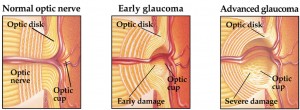By David A. Goldman MD –
 Glaucoma is a condition of the eye where the internal pressure of the eye is too high, such that it compresses and causes injury to the optic nerve. A structure called the ciliary body creates fluid, known as aqueous humor, which is drained through a structure known as the trabecular meshwork, located in the “angle” of the eye. Elevated pressure can arise because of over production of fluid or poor drainage of fluid.
Glaucoma is a condition of the eye where the internal pressure of the eye is too high, such that it compresses and causes injury to the optic nerve. A structure called the ciliary body creates fluid, known as aqueous humor, which is drained through a structure known as the trabecular meshwork, located in the “angle” of the eye. Elevated pressure can arise because of over production of fluid or poor drainage of fluid.
One of the most dangerous forms of glaucoma is acute angle-closure glaucoma. In this type of glaucoma, the angle becomes completely blocked suddenly. Because the eye continues to produce aqueous, the pressure of the eye rapidly increases to incredibly high numbers. Typically patients will develop rapid loss of vision and pain in the eye. If untreated, this can quickly result in permanent loss of vision. Fortunately, using a laser to create a conduit for the aqueous to recirculate can oftentimes stop the condition. During routine eye examinations, if the patient’s angles are noted to be very narrow, this laser treatment can be done prophylactically to prevent potential problems in the future.
The more common type of glaucoma is open angle glaucoma. In this condition, the pressure may be slightly elevated. When the optic nerve is compressed from elevated pressure, the vision loss occurs in the peripheral field of vision first. Thus, most patients with this condition are asymptomatic until very late in the course of the disease. The typical treatments include topical eye drops to decrease the production of aqueous in the eye. In many cases, a laser treatment can be performed to the drainage system of the eye to improve the outflow of aqueous. In simple terms it can be thought of as putting Draino down a clogged sink. By allowing aqueous to flow out of the eye more easily, the overall pressure is reduced. This procedure can be done in minutes and is typically without any discomfort or side effects. For severe recalcitrant forms of glaucoma, surgery may be required. Typically these surgeries involve recreating a new drainage system for the eye. Though complications can occur from the procedures, newer devices and developments are being made that can be less invasive and better tolerated.
The most important thing in treating glaucoma is to catch it in the early stages. Oftentimes, if this is achieved then it is more easily treated and patients do not suffer much vision loss. Obtaining regular eye examinations is important, particularly if you have a family history of glaucoma as some forms can be hereditary.
561-630-7120
www.goldmaneye.com
Check Also
The Latest Technology With Hearing Aids
Many modern electronic devices these days come equipped with Bluetooth technology. This feature lets you …
 South Florida Health and Wellness Magazine Health and Wellness Articles
South Florida Health and Wellness Magazine Health and Wellness Articles




